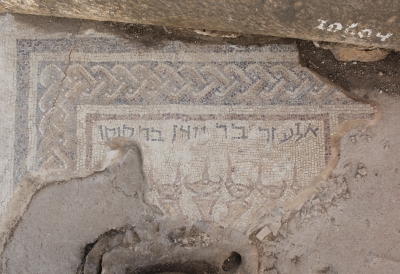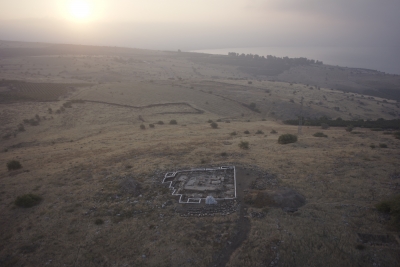
Unique mosaic floor discovered in Israel
A marvelous mosaic synagogue floor has been discovered at the Israeli excavation site of Horvat Kur. The timeworn stones of the mosaic clearly form the name ‘El’azar’. Leiden University researcher Jürgen Zangenberg and a group of Leiden students played a role in the excavation. ‘El’azar was likely an important inhabitant of the region between the 4th and 7th century.
Inscriptions
Inscriptions mentioning sponsors of public buildings are a common feature in the ancient world, including Jewish synagogues, Christian churches and pagan temples. But the specific combination of names in the Horvat Kur inscription has never been seen before which makes this find special.
 |
| The name 'El'azar' reads from recht to left on the mosaic |
Stone by stone
It is also a special discovery for Leiden researcher Jürgen Zangenberg. As a co-director of the Kinneret Regional Project, that is coordinating the excavation in the area, he experienced the uncovering of the mosaic from start to finish. “We have known since 2013 that there was a mosaic at Horvat Kur,” he commented. “We had already found a small part of it. But when the whole mosaic eventually came to the surface, stone by stone, letter by letter, that was very special. An unforgettable experience for me as well as for the students present.”
A unique discovery
The new finds from Horvat Kur significantly advance historical knowledge of a region that is crucial to ancient Jewish and Christian history and culture. Zangenberg: “Now we will start thinking: What does this find mean? How should we interpret it?” Horvat Kur is located a few kilometres from the north-western shore of the Sea of Galilee. It is also close to important ancient Christian pilgrimage centres such as Tabgha and Capernaum. Many synagogues have been found in this region in the last ten years, to which the Horvat Kur excavations now add unique, valuable data.
 |
| The excavation site of Horvat Kur |
The Israel Museum
The mosaic has been removed from the excavation site and transported to the Israel Museum in Jerusalem. The Israel Museum will display the mosaic in 2017, together with other finds from Horvat Kur, in a major exhibition about synagogue art.
The Kinneret Regional Project is an international research collaboration sponsored by the University of Bern (Switzerland), University of Helsinki (Finland), Leiden University (The Netherlands) and Wofford College (USA).
